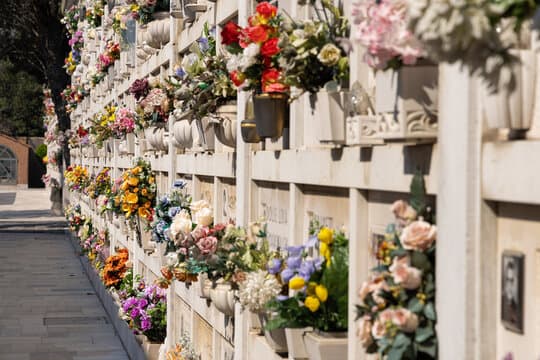Memorial Service
Memoria's Guide to Interment of Ashes: Honoring Your Loved One's Memory
Our guide seeks to shed light on the myriad methods available for the interment of ashes, ensuring that every family can navigate this path with the knowledge and confidence to make a decision that truly resonates with their heart and the wishes of their beloved departed.

In the tapestry of life, every individual leaves an indelible mark, a legacy that resonates long after they've departed. The passing of a loved one is a profound event, and the subsequent choices about how to commemorate their life are laden with emotion, significance, and a desire to honor their memory in the most fitting manner. One of the most intimate decisions families face is determining how to handle the ashes of their loved one post-cremation. This choice, while deeply personal, is also intertwined with cultural, religious, and individual preferences.
Our guide seeks to shed light on the myriad methods available for the interment of ashes, ensuring that every family can navigate this path with the knowledge and confidence to make a decision that truly resonates with their heart and the wishes of their beloved departed.
Understanding Interment of Ashes
The term 'interment' might sound formal, but at its core, it embodies a deeply emotional and spiritual act. Interment refers to the practice of placing the cremated remains of a loved one in a final resting place. This act is more than just a physical placement; it's a symbolic gesture that signifies respect, remembrance, and a continuation of the bond shared with the departed.
Throughout history, cultures worldwide have developed rituals and traditions surrounding the interment of ashes. These practices have evolved, reflecting societal changes, religious beliefs, and personal preferences. Today, the options available for interment are diverse, allowing families to choose a method that aligns with their values, emotions, and the desires of the deceased.
For many, the act of interment is a step in the grieving process. It provides a sense of closure, a moment to say a final goodbye, and a dedicated space or method to remember and honor the loved one. Whether it's a traditional burial, placing the urn in a niche, scattering the ashes in a cherished location, or any other method, the essence remains the same: to pay tribute to a life lived and to ensure that their memory lives on.
1 – Home Memorial
The concept of home transcends beyond walls and roofs; it's a haven of memories, emotions, and connections. When a loved one departs, the desire to keep them close, to feel their presence in everyday life, becomes even more pronounced. This is where the idea of a home memorial beautifully comes into play.
A home memorial is not just about placing an urn on a mantle; it's about curating a space that encapsulates the essence, memories, and legacy of the departed. It's a corner of solace, a personal sanctuary where one can sit, reflect, and feel the comforting embrace of cherished memories. Whether it's in the living room, a dedicated space, or even a garden, a home memorial offers the flexibility to design a tribute that's as unique as the individual it honors.
The beauty of a home memorial lies in its personalization. Families can adorn the space with photographs capturing candid moments, letters written but never sent, favorite books, or even personal artifacts that tell a story. Every item becomes a tangible link to the past, a bridge to the memories shared, and a testament to the bond that endures.
Moreover, a home memorial provides immediate access. Unlike visiting a cemetery or columbarium, which might be bound by timings or distances, a home memorial is always there. It's a place to start the day with a silent conversation, to seek comfort on challenging nights, or to simply reminisce on anniversaries and special occasions.
At Memoria, we recognize the profound intimacy of a home memorial, which is why we offer different styles of urns to fit your personal style. You can find traditional urns here and some more modern styles here. All urns are delivered free of charge and can be returned, should you prefer something different.
2 – Scattering Ashes
The act of scattering ashes is steeped in symbolism. It represents a return to nature, a release of the spirit, and a profound connection to the universe's cyclical nature. For many, it's a way to honor the wishes of the departed, allowing them to become one with their favorite places, be it the vast ocean, a serene forest, or the peak of a beloved mountain.
The choice of location often holds significant meaning. Some families choose spots that were dear to the deceased—a childhood beach, a hiking trail, or a garden where they found peace. Others might opt for places that resonate with spiritual or ancestral significance. The act becomes a bridge between the tangible and the intangible, connecting memories, emotions, and the eternal cycle of life and death.
However, it's essential to approach the act with sensitivity and awareness. Different regions have regulations regarding the scattering of ashes, ensuring that the environment remains protected and that the act is done with respect. It's advisable to research and seek permissions if required, ensuring that this final tribute aligns with legal and environmental considerations.
For those who wish to scatter ashes but also desire a physical memorial, there are options to retain a small portion of the ashes. These can be placed in keepsake urns (small urns), into cremation jewelry, transformed into diamonds or even incorporated into art, ensuring that there's a tangible memory to hold onto.
At Memoria, our dedicated advisors offer guidance on the process, from selecting meaningful locations to understanding legalities and ensuring that the act is both therapeutic and respectful. Contact us at support@memoria.co to organize a scattering of ashes.
3 – Columbarium Niche
The columbarium, a word derived from the Latin term "columba" meaning "dove," has ancient roots that trace back to structures designed to house doves and pigeons. Over time, this concept evolved, and today, a columbarium stands as a sacred space specifically crafted to house urns containing the cremated remains of loved ones.
A columbarium niche is more than just a compartment within a wall or structure; it's a testament to a life lived, a space of honor, and a focal point of remembrance. Each niche, often sealed with glass or a decorative front, provides a dedicated space for an individual urn. This allows families to not only safely store the remains but also to personalize the space with photographs, mementos, and inscriptions that capture the essence of the departed.
One of the most poignant aspects of choosing a columbarium niche is the sense of community it fosters. Unlike isolated burial plots, a columbarium brings together multiple families, all united in their journey of remembrance. This communal setting can be a source of solace, knowing that one's loved one rests among others, in a place frequently visited and revered by many.
Furthermore, columbaria are often located within serene settings—churches, memorial parks, or dedicated sections of cemeteries. Their architectural beauty, combined with the peaceful surroundings, offers a tranquil space for reflection, prayer, and connection.
Opting for a columbarium niche also provides a level of flexibility. Some families choose to reserve adjacent niches, ensuring that loved ones remain close even in the afterlife. Additionally, the maintenance and upkeep of the columbarium are typically handled by the managing institution, relieving families of any long-term concerns.
4 – Traditional Burial
The concept of burial is as old as human civilization itself. From the ancient pyramids of Egypt to the serene cemeteries of today, the act of laying a loved one to rest in the earth has been a cornerstone of human culture and tradition. Traditional burial, especially for cremated remains, offers a tangible link to this rich history, providing families with a time-honored method to honor their departed.
When we speak of a traditional burial for ashes, we refer to the practice of interring an urn or container holding the cremated remains in a designated plot within a cemetery or burial ground. This method offers several unique advantages. Firstly, it provides a physical location—a sacred space—where family and friends can visit, reflect, and pay their respects. Over time, this space becomes a beacon of memories, a place where stories are shared, tears are shed, and the legacy of the departed is celebrated.
Additionally, traditional burials often align with religious or cultural practices. Many faiths have specific rituals and ceremonies associated with burial, offering solace and guidance to the bereaved. These rituals can be a source of comfort, providing a structured way to navigate the complexities of grief.
Another aspect to consider is the sense of permanence that a burial plot offers. Unlike some other methods of interment, a burial plot serves as a lasting tribute to the deceased. It's a place that future generations can visit, ensuring that the memory of the loved one is passed down and revered.
At Memoria, our team is dedicated to guiding families through the process, ensuring that every detail—from selecting the perfect plot to organizing a meaningful graveside ceremony—is handled with care, respect, and empathy. For further information check our Memorial page: https://memoria.co/memorials
5 – Burying Ashes in a Biodegradable Urn
In an age where environmental consciousness is paramount, the choice of interment methods has evolved to reflect a harmonious balance between honoring the departed and preserving the planet. Burying ashes in a biodegradable urn stands at the forefront of this evolution, offering a way to commemorate a loved one while leaving a minimal ecological footprint.
A biodegradable urn is crafted with materials that naturally break down over time, such as paper, natural clays, or organic fibers. When buried, these urns decompose, allowing the ashes within to merge seamlessly with the earth. This process symbolizes a return to nature, a reconnection with the circle of life, and a tribute that resonates with the rhythms of the earth.
One of the most profound aspects of this method is the potential for creating a living memorial. Many biodegradable urns are designed to be paired with seeds or saplings. As the urn decomposes, the seeds take root, drawing nourishment from the ashes and eventually growing into a tree, plant, or flower. This growth stands as a living testament to the departed, a symbol of life's continuity and the enduring impact of the individual's presence.
At Memoria, we recognize the profound significance of this eco-friendly choice. Our team is dedicated to guiding families through the process, from selecting the perfect biodegradable urn to choosing a meaningful location for burial.
6 – Creating Jewelry
Jewelry has always been powerful mediums to convey emotions, stories, and memories. When intertwined with the essence of a loved one, they transform into profound keepsakes that bridge the realms of the tangible and intangible, capturing the spirit and legacy of the departed in a form that can be seen, touched, and cherished.
Jewelry, with its close proximity to the body, offers a constant reminder of the bond shared with the departed. Ash-infused jewelry ranges from rings and pendants to bracelets and earrings. These pieces can be designed with compartments to hold the ashes or crafted using processes that fuse the ashes into the material itself. Every time the jewelry is worn, it serves as a touchpoint, a silent conversation, and a symbol of enduring love.
At Memoria, we collaborate with skilled artisans and jewelers, guiding families through the process and ensuring that the final creation is a fitting tribute that captures the essence, memories, and legacy of the departed.
7 – Memorial Gardens and Forests
Nature, with its innate beauty and tranquility, has always been a source of solace and reflection for many. Memorial gardens and forests tap into this natural serenity, offering families a peaceful and organic setting to commemorate their loved ones. These spaces are more than just plots of land; they are sanctuaries where memories flourish, and the legacy of the departed intertwines with the rhythms of nature.
Memorial Gardens: These are meticulously designed spaces, often adorned with flowers, shrubs, water features, and pathways. Each element is chosen not just for its aesthetic appeal but for its symbolic significance. Families can choose dedicated spots within these gardens to place plaques, benches, or even sculptures that honor their loved ones. The changing seasons, the bloom of flowers, and the gentle rustle of leaves all contribute to a dynamic tribute that evolves with time, reflecting the ever-present nature of memories.
Memorial Forests: A step further into the embrace of nature, memorial forests offer a more immersive experience. Here, the concept is to let the ashes of the departed nurture the growth of trees. Biodegradable urns, often paired with tree saplings, are buried, allowing the ashes to enrich the soil. Over time, these saplings grow into majestic trees, standing tall as living memorials. Families can visit these forests, find solace under the canopy, and feel a profound connection, knowing that their loved one is now a part of this thriving ecosystem.
Additional Considerations
The journey of commemorating a loved one is deeply personal and multifaceted. While the primary methods of interment and remembrance play a central role, there are several additional considerations that families should be aware of to ensure that the chosen tribute is both meaningful and aligned with various practicalities.
1. Wishes of the Deceased: Before finalizing any memorial method, it's paramount to reflect on any known wishes of the departed. Did they express a preference for a particular type of interment or memorial? Respecting their desires can offer a sense of fulfillment and peace to the bereaved.
2. Feelings of Family Members: The process of memorialization impacts the entire family. It's essential to engage in open conversations, ensuring that all voices are heard and that the chosen method resonates with the collective sentiment of the family.
3. Religious and Cultural Practices: Different cultures and religions have specific rituals, beliefs, and practices associated with death and memorialization. Being aware of and respecting these traditions can add depth and significance to the chosen memorial method.
4. Financial Considerations: While the emotional aspects are paramount, it's also essential to consider the financial implications of the chosen method. Some options might require ongoing maintenance costs, while others might have one-time expenses. Planning ahead can ensure that the tribute is sustainable in the long run.
5. Long-term Maintenance: Some memorial methods, like burial plots or columbarium niches, might require regular upkeep. Understanding the responsibilities and ensuring that there's a plan in place can offer peace of mind to families.
6. Legal and Environmental Regulations: Whether it's scattering ashes in a specific location or choosing a biodegradable urn, being aware of local regulations and environmental guidelines is crucial. This ensures that the act of memorialization is respectful to both the community and the environment.
7. Personalization and Flexibility: The world of memorialization offers numerous opportunities for personalization. From inscriptions on plaques to the design of urns, families can infuse personal touches that truly capture the essence of the departed.
At Memoria, we believe that every individual's life is unique, and their memorial should reflect that distinctiveness. Our dedicated team is here to guide families through these additional considerations, ensuring that every aspect of the memorial journey is handled with care, respect, and empathy.
Reach out to us over email at support@memoria.co or give us a call at (929) 295-4401.


